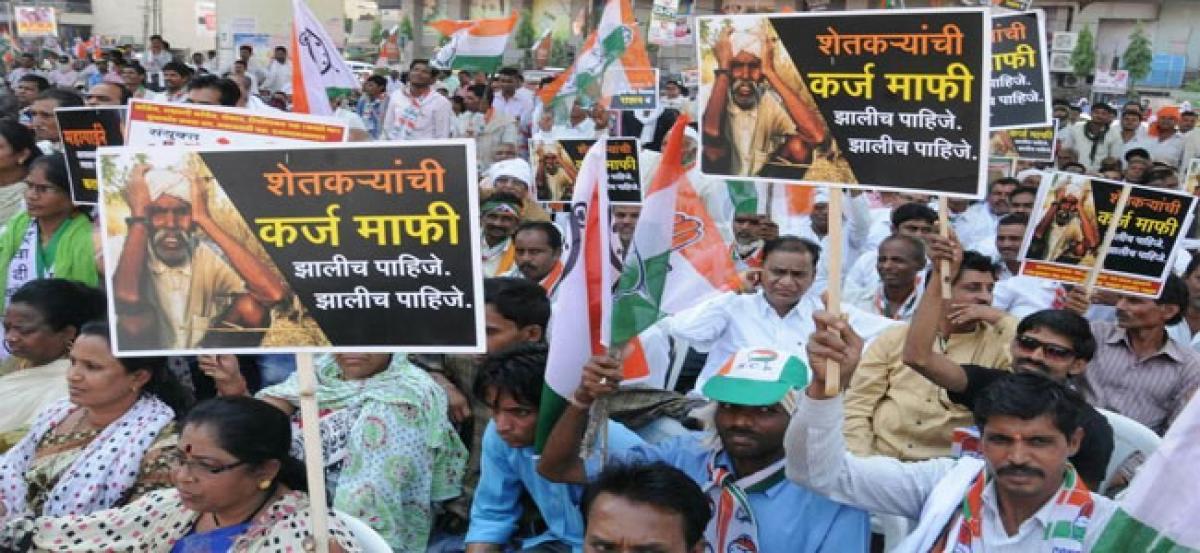Live
- Basavanagudi Kadalekai Parishe: Govt gives good news to groundnut traders
- Yanamala blames YSRCP policies for collapse of state economy
- Call to inculcate habit of reading books
- 63% parents give milk to their kids to maintain intake of calcium
- Maoist Leader Manjula Surrenders in Warangal, Receives ₹20 Lakh Reward
- Kartika Purnima celebrations fervour marks Telugu States, devotees flock to shiva shrines
- YSRCP alleges meagre fund allocations for Super Six schemes
- Telangana CM Reviews Plans for First Anniversary of State Government
- Vijayawada: Kindness Day celebrated
- Rajamahendravaram: Students advised to set clear goals
Just In

In 2014, Andhra Pradesh and Telangana announced farm loan waivers of Rs 24,000 crore and Rs 17,000 crore respectively, and Tamil Nadu in 2016.
In 2014, Andhra Pradesh and Telangana announced farm loan waivers of Rs 24,000 crore and Rs 17,000 crore respectively, and Tamil Nadu in 2016.
Domino effects were seen in 2017 in several states and Uttar Pradesh (UP), Karnataka, Maharashtra and Punjab have announced loan waivers for farmers. The total cost of loan waivers announced amounts to around Rs 1,30,000 crore (0.8 per cent of GDP). UP and Maharashtra alone account for 17% of total agricultural loans to farmers, according to RBI Governor Urjit Patel.
The RBI Governor made it clear that the first impact of any loan waiver will be on the balance sheet of lending institutions, be they formal or informal. This is inherent in the inevitable lags, in the timing of impact and the arrival of compensation from the government. In this interregnum, the quality of assets deteriorates and bridge provisions crowd out new loans.
What constrains Indian farmers?
Deep-seated distortions that render agriculture vulnerable to high volatility. It has perennially been characterised by low investment, archaic irrigation practices, monsoon dependence, and fragmentation of land holdings and low level of technology. Lack of property rights and low initial net worth of farmers add to the constraints
In the second round, loan waivers impact the state of public finances in the form of higher than budgeted revenue expenditure. This, in turn, has to be financed by additional market borrowings which push up interest rates, not just for the states but for the entire economy.
In the recent period, farm loan waivers have engaged intense attention. On one hand, there is a gamut of issues that have intensified the anguish of our farmers. In this context, farm loan waivers stress the urgency of designing lasting solutions to the structural malaise that affects Indian the agriculture.
On the other, there are concerns about macroeconomic and financial implications, how long they will persist in impacting the economy, the possible distortions that they could confront public policies with, and the ultimate incidence of the financial burden.
India’s agrarian economy contributes about 15 per cent to GDP, forms 11 per cent of exports and provides livelihood to about half of India’s population. The importance of the sector from a macroeconomic perspective is also reflected in a significant flow of bank credit to the agriculture and allied sectors relative to other sectors of the economy.
Outstanding bank advances to agriculture and allied activities have risen from about 13 per cent of GDP in 2000-01 to around 53 per cent in 2016-17. In real terms (adjusted for inflation measured by the GDP deflator), the growth of bank credit to agriculture and allied activities accelerated from 2.6 per cent in the 1990s to 15.4 per cent during 2000-01 to 2016-17.
Much of this credit flow has been propelled through priority sector lending (PSL). The share of agriculture and allied activities in total priority sector advances increased from 32.5 per cent in 2000-01 to 43.2 per cent in 2016-17 and thus, without exaggeration, it is safe to say that financial flows to agriculture have been significant.
Despite the sizeable volume of subsidised and directed credit flows as well as the various fiscal incentives, Indian agriculture is beset with deep-seated distortions that render it vulnerable to high volatility. It has perennially been characterized by low investment, archaic irrigation practices, monsoon dependence, and fragmentation of land holdings and low level of technology. Lack of property rights and low initial networth of farmers add to the constraints.
Consequently, considerable flux in output and prices is common, imposing large losses on farmers and potentially imprisoning them in a circle of indebtedness with disturbing frequency. Therefore, in the absence of coordinated and sustained efforts to put the agriculture on track, loan waivers have periodically emerged as a quick fix to ease farmers’ distress,
maintains the RBI Governor, while highlighting past experiences that loan waivers would be detrimental to nation’s growth, since, ultimately, loan waivers involve a transfer of resources from tax payers to borrowers.
By Gudipati Rajendera Kumar

© 2024 Hyderabad Media House Limited/The Hans India. All rights reserved. Powered by hocalwire.com







